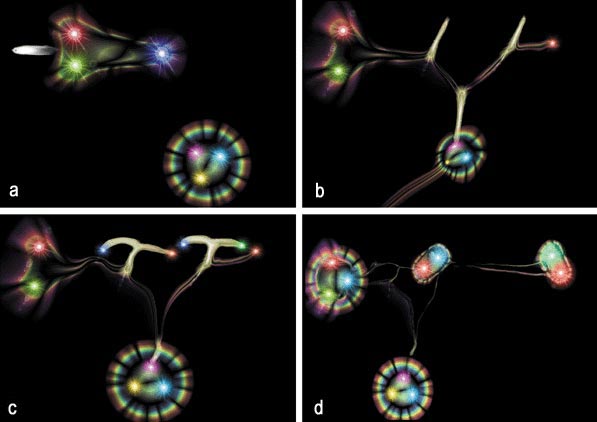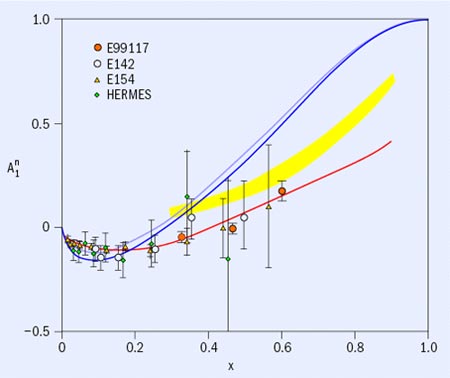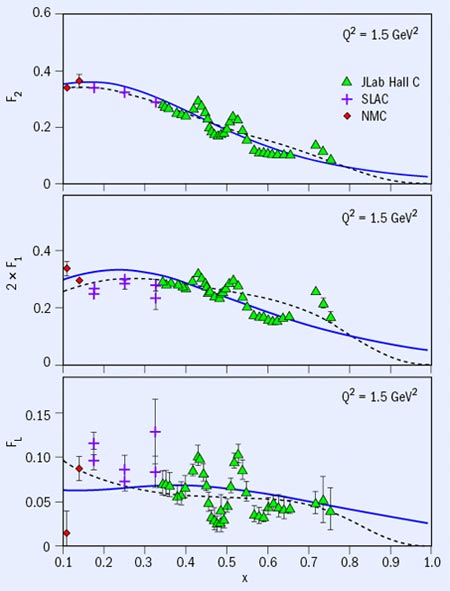Experiments at the boundary of nuclear physics and particle physics are providing a clearer view of the nucleus in terms of the basic quarks and gluons, as Douglas Higinbotham describes.
The year 1969 saw the publication of the first results indicating that hard scattering centres exist deep inside protons. A collaboration between the Stanford Linear Accelerator Center (SLAC) and the Massachusetts Institute of Technology was using SLAC’s new high-energy electron linac to pioneer a rich new field in the study of the nucleus – deep inelastic scattering. Their measurements revealed that nucleons are made up of point-like particles, which Richard Feynman dubbed “partons”. Thirty-five years on, studies of the parton-nature of the nucleus continue, not only at the traditional high-energy centres, but also at lower-energy laboratories, and in particular at the Thomas Jefferson National National Accelerator Facility (Jefferson Lab) in Virginia.

Jefferson Lab is home to the Continuous Electron Beam Accelerator Facility (CEBAF). Its main mission is to explore the atomic nucleus and the fundamental building-blocks of matter. As part of this mission, researchers there study the transition from the picture of the nucleus as a bound state of neutrons and protons to its deeper structure in terms of quarks and gluons – in other words, the transition from the hadronic degrees of freedom of nuclear physics to the quark-gluon degrees of freedom of high-energy physics. In exploring this transition, a wide range of experiments has been performed, from measurements of elastic form factors at large momentum transfers to studies of deep inelastic scattering.
An array of spectrometers together with electron-beam energies of up to 5.7 GeV has allowed the laboratory to make significant contributions to this field. This article describes three experiments, each aimed at improving our understanding of a different aspect of the partonic nature of matter. The first, a classic deep inelastic scattering experiment, seeks to further our understanding of the composition of nucleon spin. The second experiment studies the concept of quark-hadron duality – a link between the deep inelastic region and the resonance region. The third experiment uses the atomic nucleus as a laboratory to improve understanding of the propagation and hadronization of quarks. Jefferson Lab’s ability to perform this range of measurements is illustrated by the plot from the CEBAF Large Acceptance Spectrometer (CLAS) shown on the cover of this magazine, where the hadronic resonance peaks are seen to be washed out as one goes from the delta resonance around 1.2 GeV to higher invariant masses and into the deep inelastic scattering realm of quarks and gluons.
The spin of the nucleon
In the 1980s, experiments at CERN and SLAC showed that only a small fraction of the nucleon spin is carried by the quarks. Since then, many experiments have been done to solve this “spin crisis”. Our current understanding of nucleon spin is that it is the sum of the spins of the valence quarks and the q and the qbar sea quarks, the orbital angular momenta of quarks and the spins of gluons. While many experiments have been performed in the region of low Bjorken x, where sea quarks and gluons dominate, it has been experimentally challenging to make measurements in regions of higher Bjorken x, where the valence quarks are predicted to dominate.

Using the high-resolution spectrometers in Hall A with a polarized 3He target, Jefferson Lab has recently completed a measurement in the valence-quark region of the neutron spin asymmetry An1. At large momentum-transfer squared (Q2) this asymmetry is approximately the ratio of the polarized and unpolarized structure functions: g1/F1. Perturbative quantum chromodynamics (QCD) as well as constituent quark models predict that this ratio should tend towards unity as Bjorken x goes to unity, while simple calculations based on SU(6) symmetry predict that An1 should be zero. Previously, the An1 data in the range of x from 0.4 to 0.6 were consistent with zero. However, the new high-precision data from experiment E99-117 at Jefferson Lab, shown in figure 1, indicate that the An1 asymmetry is becoming positive and hints that it may indeed approach unity (Zheng et al. 2004). This result reveals strong SU(6) symmetry-breaking and agrees best with calculations that include quark orbital angular momenta.
Quark-hadron duality
In the early 1970s, Elliott Bloom and Fred Gilman proposed that resonances created in electroproduction are a “substantial part of the observed scaling behaviour of inelastic electron-proton scattering”. They showed that by appropriately averaging data in the resonance region, the resonance data could be smoothly linked with deep inelastic data. The authors were careful to state that they had not predicted the scaling behaviour of deep inelastic scattering, but that they had pointed out a phenomenological correlation that hinted at a common origin. This phenomenon has become commonly known as quark-hadron duality.
Recent results from Jefferson Lab’s Hall C have shown that duality works quantifiably better and over a larger Q2 range than previously thought (Niculescu et al. 2000, Ent et al. 2000). Using data in the nucleon-resonance region, it has been shown that it is possible to use the idea of duality to extract the proton’s magnetic form factor as well as the ratio of longitudinal to transverse deep inelastic electron-proton scattering cross-sections. Recent structure function data in the resonance region from Hall C are shown in figure 2. These data show that even for the different structure functions, the resonance data oscillate about curves generated from fits to deep inelastic scattering.

The successful application of duality to extract known quantities suggests that it should also be possible to use it to extract quantities that are otherwise kinematically inaccessible. For example, analysis is now under way on data from experiment E01-012 at Jefferson Lab, which is using duality to determine the An1 asymmetry to higher Bjorken x values than are kinematically accessible through deep inelastic scattering. As a check of its validity, this extraction will partially overlap the deep inelastic scattering An1 data.
Propagation of quarks
A recent experiment in Hall B at Jefferson Lab using CLAS has made measurements to improve our understanding of quark propagation through cold QCD matter. The data from this experiment, which are now being analysed, should shed light on two topics: quark hadronization and quark energy loss (as shown schematically in the artist’s impression above).
Owing to confinement, a quark struck with sufficient energy will produce multiple hadrons through a process known as hadronization. This process is uniquely described by QCD. While the evolution of quarks into hadrons cannot be seen directly, the attenuation of the leading particles emerging from deep inelastic scattering can be determined and used to gain insight into the hadronization process.
Before the quark hadronizes, it can be considered to be travelling through the colour field of the nucleus. QCD predicts that as the quark traverses the nucleus, it will lose energy by emitting gluons. This is similar to how in quantum electrodynamics a charged particle moving through matter loses energy by emitting photons. The energy loss of the quark in the QCD process can be studied by observing the properties of the leading particles in deep inelastic scattering from different nuclei. Preliminary analysis of these data has shown that a majority of the lightest particles (pions) with the largest relative energy are strongly attenuated as one goes from light nuclei to heavy nuclei. This observation is in sharp contrast to the naive view that the nucleus is a benign spectator. The quantitative results of this experiment will be forthcoming.
In summary, three experiments from Jefferson Lab, one from each experimental hall, illustrate a different aspect of the partonic nature of matter. These experiments, along with others being performed around the world, are refining our understanding of the fundamental building-blocks of matter. With the proposed upgrade of its accelerator to 12 GeV, the laboratory will be able to cover an even greater kinematic range as it continues to map out the transition from hadronic degrees of freedom to quark-qluon degrees of freedom, providing an increasingly accurate portrait of the nucleus.
Further reading
R Ent et al. 2000 Phys. Rev. D 62 073008.
Y Liang et al. 2004 www.arxiv.org/abs/nucl-ex/0410027 submitted to Phys. Rev. Lett.
I Niculescu et al. 2000 Phys. Rev. Lett. 85 1182, 1186.
X Zheng et al. 2004 Phys. Rev. Lett. 92 012004.








